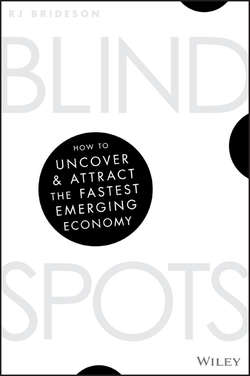Читать книгу Blind Spots - Brideson RJ - Страница 6
На сайте Литреса книга снята с продажи.
Preface
ОглавлениеImagine a page with the heading ‘Gender' at the top. On one side we list issues that we encounter in the HR or culture department, such as unconscious bias, wage gap, glass ceiling, equal opportunity and workforce diversity.
Somewhere at the bottom of the page we note more personal subjects around sexuality and identity, such as transgender evolutions, sexual preferences and the blurring of domestic roles.
Then over on the other side of the page we add another large head-ing, ‘Womenomics' or ‘The female economy', then note down some of the economic issues relating to women's impact in the marketplace and their financial leverage today in the consumer economy.
Now many of these points can be connected by dotted or blurry lines, but still they are all very different subjects.
It is no wonder that confronting these issues is inherently confusing, which often means this useful exercise ends up in the ‘too hard basket'.
On the HR side, many workplace headaches and difficulties can make us feel a bit uneasy, emotional or just worn out. Years of discussion of all this have made us a bit weary and wary, but treating genders equally while celebrating their differences is such an important dynamic when it comes to moving society forward. Unconscious bias is tricky because normally it is not visible on the surface. So if it is not apparent, how do we tackle it?
Sexuality and gender roles are so much wrapped up in personal preferences and lifestyle values that it's a bit like our political inclina-tions: we don't usually go around discussing them or justifying them because they involve individual choice. Nonetheless these issues often crop up at work and need to be understood because of the way they can affect the business or financial discussions of males and females as markets.
That women have a distinctive economic role is a fairly new revelation in the business world. Many business leaders don't know about it or understand it, or they don't see it as relevant to their bottom line. For many different reasons, they think the homogenising of gender is not an issue. They have traditionally viewed the world through a male lens, and they don't see why we should upset the applecart by changing this now.
‘Gender' is a word that makes many of us shrink and feel instantly defensive. It speaks to who we are in everyday life: the way we dress, which bathroom we use, how we identify ourselves and others. That's why it's a subject of nuance, and often confusion, and a political hot potato. But that doesn't mean we should ignore it.1
For a woman, presenting these arguments is especially problematic, for a really simple reason: most people think they are about to enter into an ‘HR / bias / feminist' discussion. Not true!
As a woman working in this market, I have built something of a reputation as an expert on gender opportunity. Still I find that many would rather dismiss such concerns as ‘women's problems' than take the time to understand that I am talking about ways the business might be more financially successful.
Culture/workplace gender issues, sexuality, the female economy (womenomics). When writing this book, I worked to keep the three subjects distinct in order to better understand them and appreciate what each brings to the discussion. But the fact is they are all part of the overall mix, so keep that page in your head and continue to visualise those dotted lines linking them. As you read this book, I hope you will start to see gender as a wonderfully powerful term associated with profits, product developments and market disruption, rather than as big blind spots.
The numbers and facts around womenomics are black and white, but there is still a big grey area to address – and that's what we'll be doing in the pages that follow.
Addressing our gender differences, when it comes to business, can lead to big bucks – so stick with me!
This book was written for forward-thinking trailblazers who are ready to take positive action in their businesses and organisations. It closes the gap between wanting to create change and knowing why we need it. It's for those decision makers who are having the conversation but are struggling with how to look at it all from a new perspective. And it's for the leaders at the top who will be influenced by the determined, enterprising folk who work with them.
Together, we'll bridge all levels of the organisational chart to explore how acknowledging our different perspectives can add up to more revenue.
We'll look at how tradition has created a false myopia and why learning to see the way the world has changed can illuminate some of the blind spots that persist in corporations around the globe today. To not see gender is to limit yourself to one perspective or lens and to miss the greater opportunity entirely. If you will suspend your disbelief and keep both your eyes and your mind wide open, this book will be transformational to your future business.
Let's begin.
1
I'm going to show you why we need to think otherwise.
